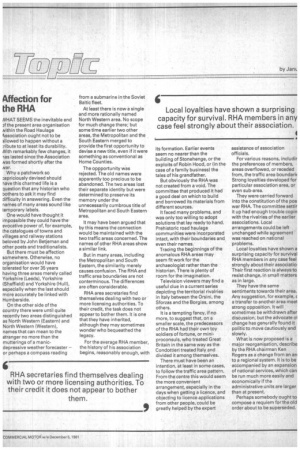Affection for the RHA
Page 33

If you've noticed an error in this article please click here to report it so we can fix it.
NHAT SEEMS the inevitable end )f the present area organisation Nithin the Road Haulage 4ssociation ought not to be 31lowed to happen without a :ribute to at least its durability. Nith remarkably few changes, it las lasted since the Association was formed shortly after the Na r.
Why a patchwork so )apriciously devised should lave this charmed life is a question that any historian who dothers to agk it may find lifficulty in answering. Even the names of many areas sound like temporary labels.
One would have thought it impossible they could have the evocative power of, for example, the catalogues of towns and villages and railway stations beloved by John Betjeman and other poets and traditionalists.
But there must be affection somewhere. Otherwise, no organisation would have tolerated for over 35 years having three areas merely called Yorkshire (Leeds), Yorkshire (Sheffield) and Yorkshire (Hull), especially when the last should more accurately be linked with Humberside.
On the other side of the country there were until quite recently two areas distinguished as North Western (Eastern) and North Western (Western), names that can mean to the Stranger no more than the mutterings of a manicdepressive weather forecaster — or perhaps a compass reading from a submarine in the Soviet Baltic fleet.
At least there is now a single and more rationally named North Western area. No scope for much change there; but some time earlier two other areas, the Metropolitan and the South Eastern merged to provide the first opportunity to devise a new title, even if it were something as conventional as Home Counties.
The oppportunity was rejected. The old names were apparently too precious to be abandoned. The two areas lost their separate identity but were determined to preserve its memory under the unnecessarily cumbrous title of Metropolitan and South Eastern area.
It may have been argued that by this means the:connection would be maintained with the two traffic areas concerned. The names of other RHA areas show a similar link.
But in many areas, including the Metropolitan and South Eastern, the similarity merely causes confusion. The RHA and traffic area boundaries are not conterminous. The differences are often considerable.
RHA area secretaries find themselves dealing with two or more licensing authorities. To their credit, the task does not appear to bother them. It is one that they have inherited, although they may sometimes wonder who bequeathed the legacy.
For the average RHA member, the history of his association begins, reasonably enough, with its formation. Earlier events seem no nearer than the building of Stonehenge, or the exploits of Robin Hood, or (in the case of a family business) the tales of his grandfather.
But obviously the RHA was not created from a void. The committee that produced it had a good deal on which to build and borrowed its materials from different sources.
It faced many problems, and was only too willing to adopt solutions that lay ready to hand. Prehistoric road haulage communities were incorporated intact, with their boundaries and even their names.
Tracing the beginnings of the anomalous RHA areas may seem fit work for the archaeologist rather than the historian. There is plenty of room for the imagination.
Television viewers may find a useful clue in a current series depicting the territorial rivalries in Italy between the Orsini, the Sforzas and the Borgias, among others.
It is a tempting fancy, if no more, to suggest that, on a smaller scale, the predecessors of the RHA had their own toy soldiers of fortune, or miniproconsuls, who treated Great Britain in the same way as the Condottieri treated Italy and divided it among themselves.
There must have been an intention, at least in some cases, to follow the traffic area pattern. From the centre this would seem the more convenient arrangement, especially in the days when getting a licence, and objecting to licence applications from other people, could be greatly helped by the expert assistance of association officials.
For various reasons, includir the preferences of members, areas overflowed, or receded from, the traffic area bounden( Strong loyalties developed for particular association area, or even sub-area.
They were carried forward into the constitution of the pos war RHA. The committee settir it up had enough trouble copin with the rivalries of the earlier associations. Local arrangements could be left unchanged while agreement was reached on national problems.
Local loyalties have shown a surprising capacity for survival RHA members in any case feel strongly about their associatiol Their first reaction is always to resist change, in small matters as in large.
They have the same sentiments towards their area. Any suggestion, for example, c a transfer to another area meet strong opposition. It will sometimes be withdrawn after discussion, but the advocate 01 change has generally found it politic to move cautiously and slowly.
What is now proposed is a major reorganisation, describe by the RHA chairman Ken Rogers as a change from an an to a regional system. It is to be accompanied by an expansion of national services, which can be run much more easily and economically if the administrative units are larger than at present.
Perhaps somebody ought to compose a requiem for the old order about to be superseded.


































































